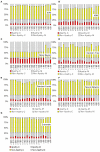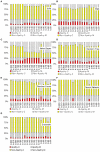Apathy Classification Based on Doppler Radar Image for the Elderly Person
- PMID: 33224927
- PMCID: PMC7670046
- DOI: 10.3389/fbioe.2020.553847
Apathy Classification Based on Doppler Radar Image for the Elderly Person
Abstract
Apathy is a disease characterized by diminished motivation not attributable to a diminished level of consciousness, cognitive impairment, or emotional distress. It is a serious problem facing the elderly in today's society. The diagnosis of apathy needs to be done at a clinic, which is particularly inconvenient and difficult for elderly patients. In this work, we examine the possibility of using doppler radar imaging for the classification of apathy in the elderly. We recruited 178 elderly participants to help create a dataset by having them fill out a questionnaire and submit to doppler radar imaging while performing a walking action. We selected walking because it is one of the most common actions in daily life and potentially contains a variety of useful health information. We used radar imaging rather than an RGB camera due to the greater privacy protection it affords. Seven machine learning models, including our proposed one, which uses a neural network, were applied to apathy classification using the walking doppler radar images of the elderly. Before classification, we perform a simple image pre-processing for feature extraction. This pre-processing separates every walking doppler radar image into four parts on the vertical and horizontal axes and the number of feature points is then counted in every separated part after binarization to create eight features. In this binarization, the optimized threshold is obtained by experimentally sliding the threshold. We found that our proposed neural network achieved an accuracy of more than 75% in apathy classification. This accuracy is not as high as that of other object classification methods in current use, but as an initial research in this area, it demonstrates the potential of apathy classification using doppler radar images for the elderly. We will examine ways of increasing the accuracy in future work.
Keywords: apathy classification; deep learning; doppler radar image; machine learning; the elderly person.
Copyright © 2020 Nojiri, Meng, Saho, Duan, Uemura, Aravinda, Prabhu, Shimakawa and Meng.
Figures












Similar articles
-
Radar Sensing for Activity Classification in Elderly People Exploiting Micro-Doppler Signatures Using Machine Learning.Sensors (Basel). 2021 Jun 4;21(11):3881. doi: 10.3390/s21113881. Sensors (Basel). 2021. PMID: 34199814 Free PMC article.
-
Screening of apathetic elderly adults using kinematic information in gait and sit-to-stand/stand-to-sit movements measured with Doppler radar.Health Informatics J. 2021 Jan-Mar;27(1):1460458221990051. doi: 10.1177/1460458221990051. Health Informatics J. 2021. PMID: 33509024
-
Comparative Analysis of Audio Processing Techniques on Doppler Radar Signature of Human Walking Motion Using CNN Models.Sensors (Basel). 2023 Oct 26;23(21):8743. doi: 10.3390/s23218743. Sensors (Basel). 2023. PMID: 37960447 Free PMC article.
-
Differential diagnosis and classification of apathy.Am J Psychiatry. 1990 Jan;147(1):22-30. doi: 10.1176/ajp.147.1.22. Am J Psychiatry. 1990. PMID: 2403472 Review.
-
[Evolution of the concept of apathy: the need for a multifactorial approach in schizophrenia].Encephale. 2013 May;39 Suppl 1:S57-63. doi: 10.1016/j.encep.2012.11.005. Epub 2013 Jan 23. Encephale. 2013. PMID: 23351930 Review. French.
Cited by
-
Detection of Peripheral Malarial Parasites in Blood Smears Using Deep Learning Models.Comput Intell Neurosci. 2022 May 24;2022:3922763. doi: 10.1155/2022/3922763. eCollection 2022. Comput Intell Neurosci. 2022. PMID: 35655511 Free PMC article.
References
-
- Breiman L. (2001). Random forests. Mach Learn. 45, 5–32. 10.1023/A:1010933404324 - DOI
-
- CabinetOfficeJapan (2019). Annual Report on the Ageing Society fy 2019. Available online at: https://www8.cao.go.jp/kourei/english/annualreport/2019/pdf/2019.pdf
-
- Charles P. (2003). Digital Video and HDTV Algorithms and Inter-Faces. San Francisco, CA: Morgan Kaufmann.
-
- Chen Q., Tan B., Chetty K., Woodbridge K. (2016). “Activity recognition based on micro-dopplersignature with in-home WI-FI,” in 2016 IEEE 18th International Conference on e-Health Networking, Applications and Services (Healthcom) (Munich: ). 10.1109/HealthCom.2016.7749457 - DOI
LinkOut - more resources
Full Text Sources

